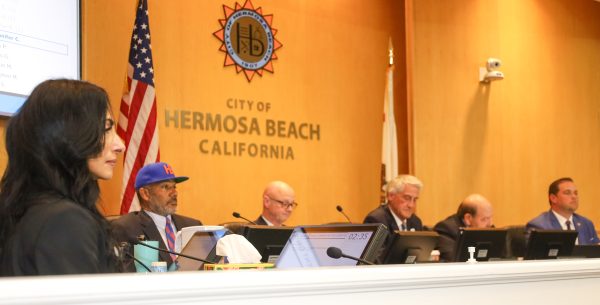
After months of fiery discussions and fundamental disagreements about the future of the city, the Hermosa Beach City Council had reached a tipping point: “Meet” or “Meet and exceed”?
The debate was one of several at Tuesday night’s council meeting surrounding the city’s goals for municipal greenhouse gas reductions that will eventually be embodied in PLAN Hermosa, the city’s revised General Plan and Local Coastal Program. And the reduction goals were themselves one of several remaining issues that needed to be hammered out before the plan and associated implementation documents come up for a vote, tentatively expected to take place at a meeting in City Council chambers Monday night.
As has been the case with other environmental provisions in the plan, the municipal greenhouse gas reductions—which cover only city facilities and operations, not the town as a whole—proved the stickiest issue. The council ultimately voted 4-1 to rewrite the goal as meeting or exceeding an 80 percent reduction in emissions, relative to 2005 levels, by the year 2030, with opportunities to “evaluate and provide reports” on progress toward the goal in 2020 and 2025. Councilmember Carolyn Petty cast the only no vote.
The majority decision comes after significant evolution in PLAN Hermosa since the Planning Commission first began holding public hearings on the document earlier this year. Previous versions of the document contained goals of “carbon neutrality” for city facilities and operations by 2020, and for the city as a whole by 2040. These prompted widespread outcry, with concerns that meeting the targets would require major sacrifices from residents. The Planning Commission, in the version of the document they agreed to send to the council for ultimate approval, jettisoned the city-wide goal in favor of a “low-carbon future” in accordance with California state standards, but kept in place the municipal carbon neutrality provision in deference to the council’s approval of the Municipal Carbon Neutral Plan in 2015.
In the interim, the feasibility of city facilities and operations reaching the carbon neutrality goal came into question. That plan relied significantly on purchasing “offsets,” under which the city would balance out local emissions by paying for reductions elsewhere in the state or country, and which were roundly criticized during PLAN Hermosa study sessions. At the state level, the practice has been increasingly denounced by both the left and right, with conservatives concerned about the cost, and environmental justice advocates worried that it tends to concentrate pollution in places already suffering from it.
Leeanne Singleton, an environmental analyst with the city, said that by 2015, the city had reduced emissions by 28 percent over 2005 levels, and projected that with ongoing and planned projects, the city would reach a 58 percent reduction by 2020. Eliminating the final 10 to 20 percent of emissions, she added, tends to be disproportionately difficult. Based on that information, staff sought council guidance about how, if at all, to tweak the goal.
Petty, however, questioned some of the assumptions underlying even the 58 percent figure, noting that approximately half of future planned reductions were dependent on the city adopting a particular type of Community Choice Aggregation (CCA) program.
“Take [the CCA] out and then we’d be hard-pressed to even meet the state goal,” Petty said.
Hermosa has been exploring a CCA, under which local governments purchase power generated from fossil fuel alternatives that is carried over the existing utility-operated grid, since 2014, and last year passed a resolution to gather further information about the program.
Petty has been consistently skeptical the financial viability of a 100 percent carbon-neutral CCA, a line of questioning that at times appeared to partially convince Councilmember Stacey Armato. Petty advocated getting rid of a numerical goal, arguing instead for a “low carbon” commitment similar to the one contained in the city-wide goal. But with a majority apparently set on strong environmental stewardship, the question became what the goal would look like, not whether it would be there at all.
Mayor Justin Massey emerged as the staunchest advocate for an aggressive goal, pointing to the recently completed installation of solar panels on the Community Center roof as proof of the type of project that could hasten emissions reductions.
Although periodic revisions to a General Plan are required by California law, the difficulty and controversy associated with PLAN Hermosa have prompted residents to wonder why it is being considered at all. Resident George Schmeltzer, who was on the City Council the last time Hermosa revised its general plan, said the complaints had a familiar ring.
Schmeltzer recalled that staff and council members were “vilified” some three decades ago when they drafted the plan that some residents are now clamoring to keep. Winkingly alluding to charges that have been leveled at current city staff and elected officials, Schmeltzer recalled being accused of “Commie plots” and “attempting to impose one-world government.”
“It’s not something municipalities take on willingly or with lots of enthusiasm,” Schmeltzer said. “But it is something that the state of California requires.”










